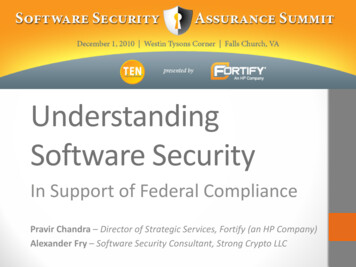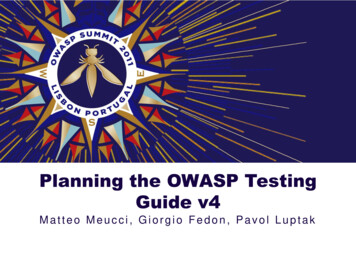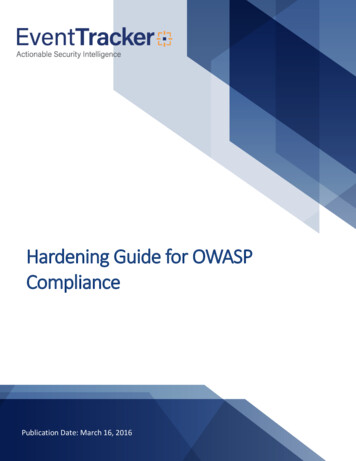
Transcription
Hardening Guide for OWASPCompliancePublication Date: March 16, 2016
Hardening Guide for OWASP ComplianceAbstractThis guide will provide an overview of the OWASP related security features and procedures built into theEventTracker product and the checks and balances made in its development cycle. This document also goesinto the details of how the EventTracker application can be deployed and hardened as per the OWASPrecommendations. It also highlights the steps taken during the development cycle to plug possible securityloop holes.AudienceThis guide helps EventTracker users to secure EventTracker application.The information contained in this document represents the current view of EventTracker. on theissues discussed as of the date of publication. Because EventTracker must respond to changingmarket conditions, it should not be interpreted to be a commitment on the part of EventTracker,and EventTracker cannot guarantee the accuracy of any information presented after the date ofpublication.This document is for informational purposes only. EventTracker MAKES NO WARRANTIES,EXPRESS OR IMPLIED, AS TO THE INFORMATION IN THIS DOCUMENT.Complying with all applicable copyright laws is the responsibility of the user. Without limiting therights under copyright, this paper may be freely distributed without permission fromEventTracker, if its content is unaltered, nothing is added to the content and credit toEventTracker is provided.EventTracker may have patents, patent applications, trademarks, copyrights, or other intellectualproperty rights covering subject matter in this document. Except as expressly provided in anywritten license agreement from EventTracker, the furnishing of this document does not give youany license to these patents, trademarks, copyrights, or other intellectual property.The example companies, organizations, products, people and events depicted herein are fictitious.No association with any real company, organization, product, person or event is intended orshould be inferred. 2017 EventTracker Security LLC. All rights reserved. The names of actual companies andproducts mentioned herein may be the trademarks of their respective owners.1
Hardening Guide for OWASP ComplianceTable of ContentsAbstract . 1Audience . 1Overview. 3Categories of OWASP . 3Information Gathering. 3Configuration Management . 5Authentication Testing . 9Authorization Testing . 13Business Logic Testing . 15Data Validation Testing . 15Denial of Service Testing . 19Web Services Testing. 21AJAX Testing . 212
Hardening Guide for OWASP ComplianceOverviewThe Open Web Application Security Project (OWASP) is an open-source application security project.Goal of OWASP: Protect EventTracker users against high risk problem areasEnsure web application securityReduce the surface area for an attacker to hack EventTracker applicationCategories of OWASPThere are 10 categories available for testing. They are:1. Information Gathering2. Configuration Management3. Authentication Testing4. Session Management5. Authorization Testing6. Business Logic Testing7. Data Validation Testing8. Denial of Service Testing9. Web Services Testing10. AJAX TestingAll the categories are applicable for EventTracker except Web Services testing.Information GatheringCollecting as much information as possible about a target application, by using public tools (search engines),scanners, sending simple HTTP requests, or specially crafted requests, it is possible to force the application toleak information, e.g., disclosing error messages or revealing the versions and technologies used.There are a few test cases in this section. Details about the test cases are given below.Test Case ID: OWASP-IG-001Test Name: Spiders, Robots and Crawlers, Not Applicable for EventTrackerDescription: Web spiders/robots/crawlers retrieve a web page and then recursively traverse hyperlinks toretrieve further web content.3
Hardening Guide for OWASP ComplianceResolution: EventTracker is an intranet application. Even though it is hosted on a website, crawler does notcrawls through the EventTracker pages if it is not logged in.Test Case ID: OWASP-IG-002Test Name: Search Engine Discovery/Reconnaissance, Not Applicable for EventTrackerDescription: This test case describes how to search the Google Index and remove the associated web contentfrom the Google Cache.Remarks: EventTracker is not a search engine based application.Test Case ID: OWASP-IG-003Test Name: Identify application entry points, Applicable for EventTrackerDescription: Enumerating the application and its attack surface is a key precursor before any thoroughtesting can be undertaken, as it allows the tester to identify likely areas of weakness. This test case aims tohelp identify and map out areas within the application that should be investigated once enumeration andmapping has been completed.Remarks: The security recommendations are incorporated in the product development and user’sintervention is not required.Test Case ID: OWASP-IG-004Test Name: Testing for Web Application Fingerprint, Applicable for EventTrackerDescription: Knowing the version and type of a running web server allows testers to determine knownvulnerabilities and the appropriate exploits to use during testing.Remarks: The security recommendations are incorporated in the product development and user’sintervention is not required.Test Case ID: OWASP-IG-005Test Name: Application Discovery, Applicable for EventTrackerDescription: A paramount step in testing for web application vulnerabilities is to find out which particularapplications are hosted on a web server. Many applications have known vulnerabilities and known attackstrategies that can be exploited in order to gain remote control or to exploit data.Remarks: The security recommendations are incorporated in the product development and user’sintervention is not required.4
Hardening Guide for OWASP ComplianceTest Case ID: OWASP-IG-006Test Name: Analysis of Error Codes, Applicable for EventTrackerDescription: Often during a penetration test on web applications we come up against many error codesgenerated from applications or web servers. It's possible to cause these errors to be displayed by using aparticular request, either specially crafted with tools or created manually. These codes are very useful topenetration testers during their activities because they reveal a lot of information about databases, bugs, andother technological components directly linked with web applications.Remarks: The security recommendations are incorporated in the product development and user’sintervention is not required.Configuration ManagementAnalysis of the infrastructure and topology architecture can reveal information about a web application.Information such as source code, HTTP methods permitted, administrative functionality, authenticationmethods and infrastructural configurations can be obtained.Test Case ID: OWASP-CM-001Test Name: SSL/TLS Testing (SSL Version, Algorithms, Key length, Digital Cert. Validity), Applicable forEventTrackerDescription: SSL and TLS are two protocols that provide, with the support of cryptography, secure channelsfor the protection, confidentiality, and authentication of the information being transmitted. Considering thecriticality of these security implementations, it is important to verify the usage of a strong cipher algorithmand its proper implementation.Resolution: Customers must configure SSL for IIS by using trusted and valid certificates.Please refer the topic ‘Secure IIS Web Server’ in Hardening Guide for EventTracker ServerTest Case ID: OWASP-CM-002Test Name: DB Listener Testing, Not Applicable for EventTrackerDescription: During the configuration of a database server, many DB administrators do not adequatelyconsider the security of the DB listener component. The listener could reveal sensitive data as well asconfiguration settings or running database instances if insecurely configured and probed with manual orautomated techniques.Remarks: This test case is only for Oracle database and EventTracker does not support Oracle Database.5
Hardening Guide for OWASP ComplianceTest Case ID: OWASP-CM-003Test Name: Infrastructure Configuration Management Testing, Applicable for EventTrackerDescription: It takes only a single vulnerability to undermine the security of the entire infrastructure, andeven small and (almost) unimportant problems may evolve into severe risks for another application on thesame server. Here we test to verify this.Resolution: User should disable remote connection to IIS. If enabling remote connection to IIS is requiredthen, default username and password like admin should be avoided.To disable remote connection in IIS, follow the steps mentioned below.1. Select the Start button, select Control Panel, and then select Administrative Tools.2. Select Internet Information Services (IIS) Manager.Figure 13. In the Connections pane, click the server node in the tree.4. To open the Management Service feature, double-click Management Service.6
Hardening Guide for OWASP ComplianceFigure 25. Disable Enable Remote Connections option, if it is checked.Test Case ID: OWASP-CM-004Test Name: Application Configuration Management Testing, Applicable for EventTrackerDescription: Web applications hide some information that is usually not considered during the developmentor configuration of the application itself. This data can be discovered in the source code, in the log files or inthe default error codes of the web servers.Remarks: The security recommendations are incorporated in the product development and user’sintervention is not required.7
Hardening Guide for OWASP ComplianceTest Case ID: OWASP-CM-005Test Name: Testing for File Extensions Handling, Applicable for EventTrackerDescription: The file extensions present in a web server or a web application make it possible to identify thetechnologies which compose the target application. File extensions can also expose additional systemsconnected to the application.Remarks: The security recommendations are incorporated in the product development and user’sintervention is not required.Test Case ID: OWASP-CM-006Test Name: Old, backup and unreferenced files, Applicable for EventTrackerDescription: Redundant, readable and downloadable files on a web server, such as old, backup and renamedfiles, are a big source of information leakage. It is necessary to verify the presence of these files because theymay contain parts of source code, installation paths as well as passwords for applications and/or databases.Remarks: The security recommendations are incorporated in the product development and user’sintervention is not required.Test Case ID: OWASP-CM-007Test Name: Infrastructure and Application Admin Interfaces, Applicable for EventTrackerDescription: Many applications use a common path for administrative interfaces which can be used to guessor brute force administrative passwords. This test tends to find admin interfaces and understand if it ispossible to exploit it to access to admin functionality. Many applications use a common path foradministrative interfaces which can be used to guess or brute force administrative passwords.Remarks: The security recommendations are incorporated in the product development and user’sintervention is not required.Test Case ID: OWASP-CM-008Test Name: Testing for HTTP Methods and XST, Applicable for EventTrackerDescription: In this test, we check that the web server is not configured to allow potentially dangerous HTTPcommands (methods) and that Cross Site Tracing (XST) is not possible.Remarks: The security recommendations are incorporated in the product development and user’sintervention is not required.8
Hardening Guide for OWASP ComplianceAuthentication TestingAuthentication is the process of attempting to verify the digital identity of the sender of a communication.Test Case ID: OWASP-AT-001Test Name: Credentials transport over an encrypted channel, Applicable for EventTrackerDescription: Here, the tester will just try to understand if the data that users put into the web form, in orderto log into a web site, are transmitted using secure protocols that protect them from an attacker or not.Resolution: Customers must configure SSL for EventTracker by using trusted and valid certificates. Pleaserefer the topic ‘Secure IIS Web Server’ in Hardening Guide for EventTracker Server.Test Case ID: OWASP-AT-002Test Name: Testing for user enumeration, Applicable for EventTrackerDescription: The scope of this test is to verify if it is possible to collect a set of valid users by interacting withthe authentication mechanism of the application. This test will be useful for the brute force testing, in whichwe verify if, given a valid username, it is possible to find the corresponding password.Resolution: Customers should follow security recommendations of Active Directory as per Microsoftguidelines. Also it is recommended that customers should not add default or guessable user accounts into theEventTracker group.Please refer the topic ‘Harden Windows Server’ in Hardening Guide for EventTracker Server.Test Case ID: OWASP-AT-003Test Name: Testing for Guessable (Dictionary) User Account, Applicable for EventTrackerDescription: Here we test if there are default user accounts or guessable username/password combinations(dictionary testing)Resolution : Customers should follow security recommendations of Active Directory as per Microsoftguidelines. Also it is recommended that customers should not add default or guessable user accounts into theEventTracker group.Please refer the topic ‘Harden Windows Server’ in Hardening Guide for EventTracker Server.9
Hardening Guide for OWASP ComplianceTest Case ID: OWASP-AT-004Test Name: Brute Force Testing, Applicable for EventTrackerDescription: When a dictionary type attack fails, a tester can attempt to use brute force methods to gainauthentication. Brute force testing is not easy to accomplish for testers because of the time required and thepossible lockout of the tester.Resolution: EventTracker depends on Windows Authentication which can be either Active Directory or localhost based. Customers should follow security recommendations of Active Directory as per Microsoftguidelines.Please refer the topic ‘Harden Windows Server’ in Hardening Guide for EventTracker Server.Test Case ID: OWASP-AT-005Test Name: Testing for bypassing authentication schema, Applicable for EventTrackerDescription: Other passive testing methods attempt to bypass the authentication schema by recognizing thatnot all of the application's resources are adequately protected. The tester can access these resources withoutauthentication.Remarks: The security recommendations are incorporated in the product development and user’sintervention is not required.Test Case ID: OWASP-AT-006Test Name: Testing for vulnerable remember password and password reset, Partially Applicable forEventTrackerDescription: Here we test how the application manages the process of "password forgotten". We also checkwhether the application allows the user to store the password in the browser ("remember password"function).Remarks: The security recommendations are incorporated in the product development and user’sintervention is not required.Test Case ID: OWASP-AT-007Test Name: Testing for Logout and Browser Cache Management, Applicable for EventTrackerDescription: Here we check that the logout and caching functions are properly implemented.Remarks: The security recommendations are incorporated in the product development and user’sintervention is not required.10
Hardening Guide for OWASP ComplianceTest Case ID: OWASP-AT-008Test Name: Testing for CAPTCHA, Not Applicable for EventTrackerDescription: CAPTCHA ("Completely Automated Public Turing test to tell Computers and Humans Apart") is atype of challenge-response test used by many web applications to ensure that the response is not generatedby a computer. CAPTCHA implementations are often vulnerable to various kinds of attacks even if thegenerated CAPTCHA is unbreakable.Remarks: EventTracker application does not have any CAPTCHATest Case ID: OWASP-AT-009Test Name: Testing Multiple Factors Authentication, Not Applicable for EventTrackerDescription: Multiple Factors Authentication means to test the following scenarios: One-time password (OTP)generator tokens, Crypto devices like USB tokens or smart cards, equipped with X.509 certificates, RandomOTP sent via SMS, Personal information that only the legitimate user is supposed to know [OUTOFWALLET].Remarks: EventTracker does not support Multiple Factors AuthenticationTest Case ID: OWASP-AT-010Test Name: Testing for Race Conditions, Applicable for EventTrackerDescription: A race condition is a flaw that produces an unexpected result when timing of actions impactother actions. An example may be seen on a multithreaded application where actions are being performedon the same data. Race conditions, by their very nature, are difficult to test for.Remarks: The security recommendations are incorporated in the product development and user’sintervention is not required.Session ManagementTest Case ID: OWASP-SM-001Test Name: Testing for Session Management Schema, Applicable for EventTrackerDescription: This describes how to analyze a Session Management Schema, with the goal to understand howthe Session Management mechanism has been developed and if it is possible to break it to bypass the usersession.Resolution: Customers are recommended to configure SSL for IIS by using trusted and valid certificates forsession variables to traverse through encrypted channel.Please refer the topic ‘Secure IIS Web Server’ in Hardening Guide for EventTracker Server.11
Hardening Guide for OWASP ComplianceTest Case ID: OWASP-SM-002Test Name: Testing for Cookies attributes, Applicable for EventTrackerDescription: Cookies are often a key attack vector for malicious users (typically, targeting other users) and, assuch, the application should always take due diligence to protect cookies. In this section, we will look at howan application can take the necessary precautions when assigning cookies and how to test that theseattributes have been correctly configured.Remarks: The security recommendations are incorporated in the product development and user’sintervention is not required.Test Case ID: OWASP-SM-003Test Name: Testing for Session Fixation, Applicable for EventTrackerDescription: When an application does not renew the cookie after a successful user authentication, it couldbe possible to find session fixation vulnerability and force a user to utilize a cookie known to the attacker.Remarks: The security recommendations are incorporated in the product development and user’sintervention is not required.Test Case ID: OWASP-SM-004Test Name: Testing for Exposed Session Variables, Applicable for EventTrackerDescription: Session Tokens represent confidential information because they tie the user identity with hisown session. It's possible to test if the session token is exposed to this vulnerability and try to create a replaysession attack.Resolution: Customers are recommended to configure SSL for IIS by using trusted and valid certificates forsession variables to traverse through encrypted channel.Please refer the topic ‘Secure IIS Web Server’ in Hardening Guide for EventTracker Server.Test Case ID: OWASP-SM-005Test Name: Testing for CSRF (Cross-site Request Forgery), Applicable for EventTrackerDescription: Cross Site Request Forgery describes a way to force an unknowing user to execute unwantedactions on a web application in which he is currently authenticated.Remarks: The security recommendations are incorporated in the product development and user’sintervention is not required.12
Hardening Guide for OWASP ComplianceAuthorization TestingTest Case ID: OWASP-AZ-001Test Name: Testing for Path Traversal, Applicable for EventTrackerDescription: In this test case, we test if it is possible to find a way to execute a path traversal attack andaccess reserved information.Resolution: Directory browsing in IIS should be disabled and files with extensions (.log & .logs) should not beserved directly.To disable directory browsing in IIS follow the steps given below:1 Select the Start button, select Control Panel, and then select Administrative Tools.2 Select Internet Information Services.ORSelect the Start button, select the Run command prompt.3 Enter inetmgr in the Open textbox and then click OK.4 Right click Default Web Site, select Properties.Figure 313
Hardening Guide for OWASP ComplianceDefault Web Site Properties window displays.5 Select Home Directory tab.Figure 46 Uncheck Directory browsing if it is selected.Test Case ID: OWASP-AZ-002Test Name: Testing for bypassing authorization schema, Applicable for EventTrackerDescription: This kind of test focuses on verifying how the authorization schema has been implemented foreach role/privilege to get access to reserved functions/resources.Remarks: The security recommendations are incorporated in the product development and user’sintervention is not required.14
Hardening Guide for OWASP ComplianceTest Case ID: OWASP-AZ-003Test Name: Testing for Privilege Escalation, Applicable for EventTrackerDescription: During this phase, the tester should verify that it is not possible for a user to modify his or herprivileges/roles inside the application in ways that could allow privilege escalation attacks.Remarks: The security recommendations are incorporated in the product development and user’sintervention is not required.Business Logic TestingTesting for business logic flaws in a multi-functional dynamic web application requires thinking inunconventional ways.Access rights of various user roles and groups are different. Every role or group has different constraints andprivileges been assigned to them.Remarks: The security recommendations are incorporated in the product development and user’sintervention is not required.Data Validation TestingTest Case ID: OWASP-DV-001Test Name: Testing for Reflected Cross Site Scripting, Applicable for EventTrackerDescription: In Cross Site Scripting (XSS) testing, we test if it is possible to manipulate the input parameters ofthe application so that it generates malicious output. We find XSS vulnerability when the application does notvalidate our input and creates an output that is under our control.Remarks: The security recommendations are incorporated in the product development and user’sintervention is not required.Test Case ID: OWASP-DV-002Test Name: Testing for Stored Cross Site Scripting, Applicable for EventTrackerDescription: In Stored Cross Site Scripting, we check if stored data are potentially exposed to this type ofattack.Remarks: The security recommendations are incorporated in the product development and user’sintervention is not required.15
Hardening Guide for OWASP ComplianceTest Case ID: OWASP-DV-003Test Name: Testing for DOM based Cross Site Scripting, Applicable for EventTrackerDescription: In DOM-based cross site scripting, we test if the active content, such as a JavaScript function, aDOM element can be controlled by an attacker or not.Remarks: The security recommendations are incorporated in the product development and user’sintervention is not required.Test Case ID: OWASP-DV-004Test Name: Testing for Cross Site Flashing, Not Applicable for EventTrackerDescription: ActionScript is the language, based on ECMAScript, used by Flash applications when dealing withinteractive needs. Flash applications are often embedded in browsers; vulnerabilities could be present inflawed Flash applications.Remarks: EventTracker does not have any Flash images.Test Case ID: OWASP-DV-005Test Name: SQL Injection, Applicable for EventTrackerDescription: In SQL injection testing, we test if it is possible to inject data into the application so that itexecutes a user-controlled SQL query in the back-end DB.Remarks: The security recommendations are incorporated in the product development and user’sintervention is not required.Test Case ID: OWASP-DV-006Test Name: LDAP Injection, Applicable for EventTrackerDescription: LDAP injection testing is similar to SQL Injection testing. The differences are that we use theLDAP protocol instead of SQL and that the target is an LDAP Server instead of a SQL Server.Remarks: The security recommendations are incorporated in the product development and user’sintervention is not required.Test Case ID: OWASP-DV-007Test Name: ORM Injection, Not Applicable for EventTrackerDescription: ORM injection testing is similar to SQL Injection Testing, as well. In this case, we use a SQLInjection against an ORM generated data access object model.Remarks: EventTracker is not an ORM supported application.16
Hardening Guide for OWASP ComplianceTest Case ID: OWASP-DV-008Test Name: XML Injection, Applicable for EventTrackerDescription: In XML injection testing, we test if it possible to inject a particular XML document into theapplication. We find an XML injection vulnerability if the XML parser fails to make appropriate datavalidation.Remarks: The security recommendations are incorporated in the product development and user’sintervention is not required.Test Case ID: OWASP-DV-009Test Name: SSI Injection, Applicable for EventTrackerDescription: In SSI injection testing, we test if it is possible to inject into the application data that will beinterpreted by SSI mechanisms. A successful exploitation of this vulnerability allows an attacker to inject codeinto HTML pages or even perform remote code execution.Remarks: The security recommendations are incorporated in the product development and user’sintervention is not required.Test Case ID: OWASP-DV-010Test Name: XPath Injection, Applicable for EventTrackerDescription: In XPath injection testing, we test if it is possible to inject data into an application so that itexecutes user-controlled XPath queries.Remarks: The security recommendations are incorporated in the product development and user’sintervention is not required.Test Case ID: OWASP-DV-011Test Name: IMAP/SMTP Injection, Applicable for EventTrackerDescription: In IMAP/SMTP injection testing, we test if it possible to inject arbitrary IMAP/SMTP commandsinto the mail servers, due to input data not properly sanitized.Remarks: The security recommendations are incorporated in the product development and user’sintervention is not required.17
Hardening Guide for OWASP ComplianceTest Case ID: OWASP-DV-012Test Name: Code Injection, Applicable for EventTrackerDescription: In code injection testing, we check if it is possible to inject into an application data that will belater executed by the web server.Remarks: The security recommendations are incorporated in the product development and user’sintervention is not required.Test Case ID: OWASP-DV-013Test Name: OS Commanding, Applicable for EventTrackerDescription: In command injection testing, we will try to inject an OS command through an HTTP request intothe application.Remarks: The security recommendations are incorporated in the product development and user’sintervention is not required.Test Case ID: OWASP-DV-014Test Name: Buffer overflow, Applicable for EventTrackerDescription: In these tests, we check for different types of buffer overflow vulnerabilities.Remarks: The security recommendations are incorporated in the product development and user’sintervention is not required.Test Case ID: OWASP-DV-015Test Name: Incubated vulnerability, Applicable for EventTrackerDescription: Incubated testing is a complex testing that needs more than one data validation vulnerability towork.Remarks: The security recommendations are incorporated in the product development and user’sintervention is not required.Test Case ID: OWASP-DV-016Test Name: Testing for HTTP Splitting/Smuggling, Applicable for EventTrackerDescription: Describes how to test for an HTTP Exploit, as HTTP Verb, HTTP Splitting, and HTTP Smuggling.Remarks: The security recommendations are incorporated in the product development and user’sintervention is not required.18
Hard
6 Hardening Guide for OWASP Compliance Test Case ID: OWASP-CM-003 Test Name: Infrastructure Configuration Management Testing, Applicable for EventTracker Description: It takes only a single vulnerability to undermine the security of the entire infrastructure, and even small and (almost) unimportant problems may evolve into severe risks for another application on the
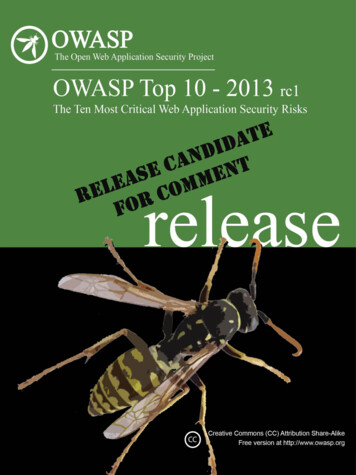
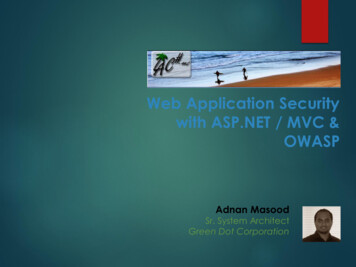
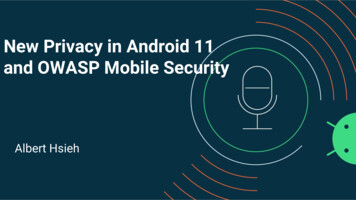

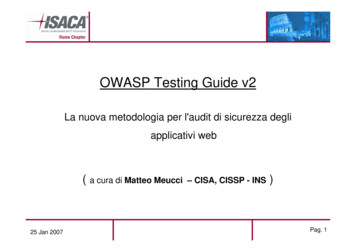
![REST API Penetration Testing Report for [CLIENT] - UnderDefense](/img/36/anonymised-api-penetration-testing-report.jpg)
